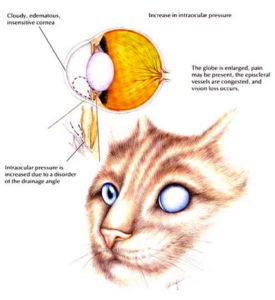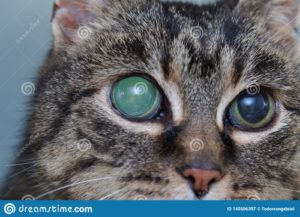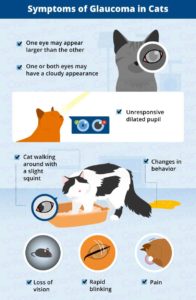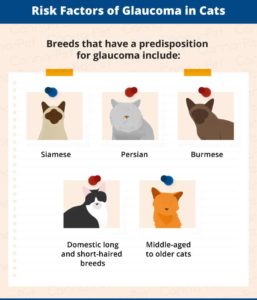Glaucoma in Cats
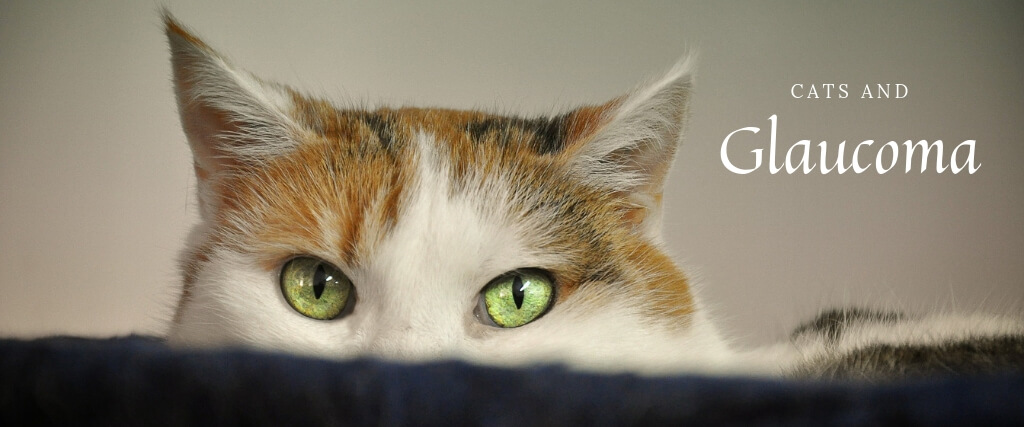
While common in people and dogs, glaucoma is rare in cats, but can ultimately lead to blindness. However, an early diagnosis coupled with the proper treatment affords concerned owners a fighting chance at saving their favorite feline friends’ purr-ecious sight.
What then, IS glaucoma?
Glaucoma is a painful disorder that occurs as a result of an abnormal increase in eye pressure (IOP or intraocular pressure). Although it can be caused by genetic factors, it’s more commonly linked to such underlying conditions as inflammation, tumors, trauma or changes in the lens that can lead to a buildup of fluid inside the eye.
Under normal conditions, clear fluid (aqueous humor) is produced within your cat’s eye. This fluid not only helps the eye maintain its shape, but it also delivers nutrients and removes metabolites during the circulation process.
In healthy eyes, the amount of fluid that’s produced is balanced by an equal amount of fluid exiting the eyes. But should there be an increase in the amount of fluid that’s being produced or if something obstructs its ability to drain normally, the liquid will build up and result in increased eye pressure.
This increase in pressure can damage the retina (the lining at the back of the eye that detects light) as well as the optic nerve, which carries impulses to the brain. If the pressure remains high for between 24 and 72 hours, it can cause permanent blindness in your cat.
Glaucoma may affect one or both eyes, and the symptoms can vary, depending on the amount of pressure, the underlying cause and how long the pressure has been elevated. Signs that your cat has glaucoma include:
Dilated pupil(s)
Enlargement or bulging of the affected eye(s)
A clear to cloudy discharge from one or both eyes
Redness and swelling of the vessels in the sclera (the white portion of the eye)
Cloudiness of the cornea (the clear outer layer of the eye)
Bumping into objects
Depression
Loss of appetite
In order to diagnose glaucoma, your vet will perform a thorough examination of your cat’s eyes and use a veterinary tonometer (a small, thin instrument resembling a thermometer) to measure the pressure inside her eyes. While elevated pressure is a sign that glaucoma is present, more sophisticated testing can be done – your vet will usually refer you to a veterinary ophthalmologist for this — to determine the cause behind the change in pressure and prescribe the appropriate course of action to treat it. The goal: to reduce the pressure, control the pain and preserve your cat’s sight.
A veterinary opthalmologist may order, among other things: x-rays and/or an ultrasound of her eye(s) to identify any abnormalities or tumors; tests to evaluate her sugar levels and the function of her kidneys, liver and pancreas; a complete blood count, urinalysis, thyroid test and tests for FeLV and FIV.
Once glaucoma has been diagnosed and medications begun, follow-up examinations are essential to ensure that your cat’s responding adequately to the treatment or, if not, to adjust her medications.
As for the prognosis? It depends on the underlying cause of her glaucoma. In the long run, ongoing medical treatment will be needed to keep the disease under control. With medical treatment alone, however, most cats will eventually lose the vision in their affected eye. If her glaucoma was caused by a detached lens and the lens is surgically removed, then the prognosis is good. If it was the result of uveitis (a form of inflammation affecting the uvea or the middle layer of tissue in the eye wall), and the inflammation is controlled, then the prognosis is good, provided the proper treatment is maintained indefinitely.
In cases that don’t respond to medical treatment or if she’s gone blind in the affected eye, removal of that eye may be recommended to relieve her pain and discomfort. But take heart. Cats who lose their sight usually adapt admirably to their situation and continue to lead happy, healthy and loving lives.

